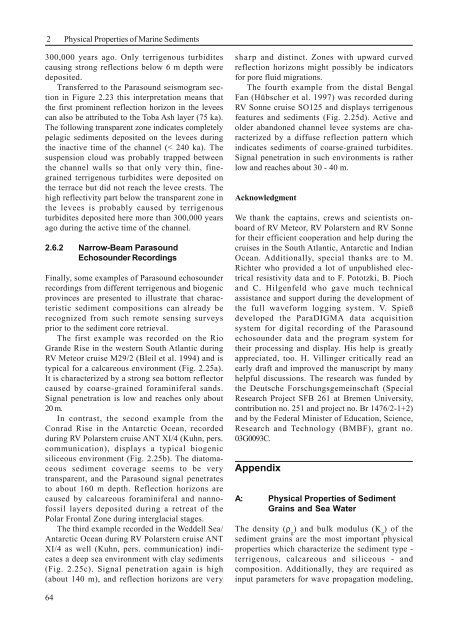2 Physical Properties of Marine Sediments - Blogs Unpad
2 Physical Properties of Marine Sediments - Blogs Unpad
2 Physical Properties of Marine Sediments - Blogs Unpad
You also want an ePaper? Increase the reach of your titles
YUMPU automatically turns print PDFs into web optimized ePapers that Google loves.
2<strong>Physical</strong> <strong>Properties</strong> <strong>of</strong> <strong>Marine</strong> <strong>Sediments</strong>300,000 years ago. Only terrigenous turbiditescausing strong reflections below 6 m depth weredeposited.Transferred to the Parasound seismogram sectionin Figure 2.23 this interpretation means thatthe first prominent reflection horizon in the leveescan also be attributed to the Toba Ash layer (75 ka).The following transparent zone indicates completelypelagic sediments deposited on the levees duringthe inactive time <strong>of</strong> the channel (< 240 ka). Thesuspension cloud was probably trapped betweenthe channel walls so that only very thin, finegrainedterrigenous turbidites were deposited onthe terrace but did not reach the levee crests. Thehigh reflectivity part below the transparent zone inthe levees is probably caused by terrigenousturbidites deposited here more than 300,000 yearsago during the active time <strong>of</strong> the channel.2.6.2 Narrow-Beam ParasoundEchosounder RecordingsFinally, some examples <strong>of</strong> Parasound echosounderrecordings from different terrigenous and biogenicprovinces are presented to illustrate that characteristicsediment compositions can already berecognized from such remote sensing surveysprior to the sediment core retrieval.The first example was recorded on the RioGrande Rise in the western South Atlantic duringRV Meteor cruise M29/2 (Bleil et al. 1994) and istypical for a calcareous environment (Fig. 2.25a).It is characterized by a strong sea bottom reflectorcaused by coarse-grained foraminiferal sands.Signal penetration is low and reaches only about20 m.In contrast, the second example from theConrad Rise in the Antarctic Ocean, recordedduring RV Polarstern cruise ANT XI/4 (Kuhn, pers.communication), displays a typical biogenicsiliceous environment (Fig. 2.25b). The diatomaceoussediment coverage seems to be verytransparent, and the Parasound signal penetratesto about 160 m depth. Reflection horizons arecaused by calcareous foraminiferal and nann<strong>of</strong>ossillayers deposited during a retreat <strong>of</strong> thePolar Frontal Zone during interglacial stages.The third example recorded in the Weddell Sea/Antarctic Ocean during RV Polarstern cruise ANTXI/4 as well (Kuhn, pers. communication) indicatesa deep sea environment with clay sediments(Fig. 2.25c). Signal penetration again is high(about 140 m), and reflection horizons are verysharp and distinct. Zones with upward curvedreflection horizons might possibly be indicatorsfor pore fluid migrations.The fourth example from the distal BengalFan (Hübscher et al. 1997) was recorded duringRV Sonne cruise SO125 and displays terrigenousfeatures and sediments (Fig. 2.25d). Active andolder abandoned channel levee systems are characterizedby a diffuse reflection pattern whichindicates sediments <strong>of</strong> coarse-grained turbidites.Signal penetration in such environments is ratherlow and reaches about 30 - 40 m.AcknowledgmentWe thank the captains, crews and scientists onboard<strong>of</strong> RV Meteor, RV Polarstern and RV Sonnefor their efficient cooperation and help during thecruises in the South Atlantic, Antarctic and IndianOcean. Additionally, special thanks are to M.Richter who provided a lot <strong>of</strong> unpublished electricalresistivity data and to F. Pototzki, B. Piochand C. Hilgenfeld who gave much technicalassistance and support during the development <strong>of</strong>the full waveform logging system. V. Spießdeveloped the ParaDIGMA data acquisitionsystem for digital recording <strong>of</strong> the Parasoundechosounder data and the program system fortheir processing and display. His help is greatlyappreciated, too. H. Villinger critically read anearly draft and improved the manuscript by manyhelpful discussions. The research was funded bythe Deutsche Forschungsgemeinschaft (SpecialResearch Project SFB 261 at Bremen University,contribution no. 251 and project no. Br 1476/2-1+2)and by the Federal Minister <strong>of</strong> Education, Science,Research and Technology (BMBF), grant no.03G0093C.AppendixA: <strong>Physical</strong> <strong>Properties</strong> <strong>of</strong> SedimentGrains and Sea WaterThe density (ρ g) and bulk modulus (K g) <strong>of</strong> thesediment grains are the most important physicalproperties which characterize the sediment type -terrigenous, calcareous and siliceous - andcomposition. Additionally, they are required asinput parameters for wave propagation modeling,64
















